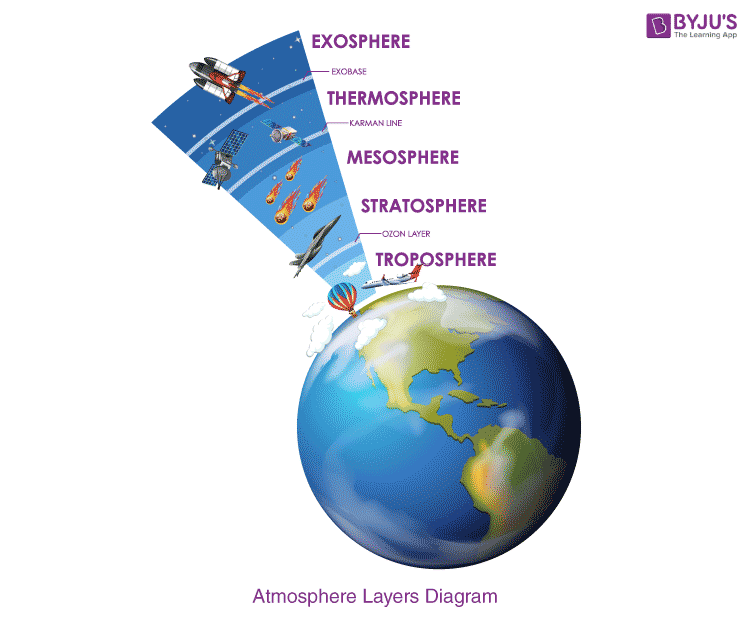Earth’s atmosphere is layered, and each layer of the atmosphere has its specific traits. The atmosphere of the Earth is divided into four layers: troposphere, Stratosphere, Mesosphere and Thermosphere, and they are separated based on temperature. Weather processes occur in the lower layers of the atmosphere while interesting events such as the beautiful aurora occur higher. By understanding how the atmosphere’s temperature changes with altitude, we can learn how the atmosphere works. In this article, let us familiarize ourselves with the layers of the atmosphere.
| Table of Contents |
Structure of the Atmosphere
Unlike the changes in pressure and density, which decrease with altitude, the temperature changes are irregular. A change in temperature with distance is called a temperature gradient. The Earth’s atmosphere is divided into layers based on the layer’s temperature gradient, and the heat source of the layer determines the temperature gradient in each layer.
Given here is a temperature gradient diagram of different layers of the atmosphere.

Troposphere
Though the sunlight reaches the Earth’s surface from top to bottom, the troposphere is primarily heated at the bottom. The Earth’s surface is much better at absorbing a wide range of solar radiation than the air. When the parcel of warm air moves upwards, it expands, and when air expands, it cools. Due to this reason, the base of the troposphere is warmer than its base because the air on the surface of the Earth absorbs the sun’s energy, gets heated up, and moves upward, which cools down.
Why is the Troposphere Warmer At The Base?
Though the sunlight reaches the Earth’s surface from top to bottom, the troposphere is primarily heated at the bottom. The Earth’s surface is much better at absorbing a wide range of solar radiation than the air. When the parcel of warm air moves upwards, it expands, and when air expands, it cools. Due to this reason, the base of the troposphere is warmer than its base because the air on the surface of the Earth absorbs the sun’s energy, gets heated up, and moves upward, which cools down.
| Similar Articles: |
Stratosphere
The Stratosphere lies above the troposphere and extends up to a height of 50 km. This layer is free of clouds and devoid of any weather-related phenomenon. Due to this, aeroplanes fly in the Stratosphere for a smooth ride. The Stratosphere also houses the ozone layer that protects us from the harmful effect of the sun’s rays.
Why is Stratosphere warmer than the troposphere?
Ozone molecules in the stratosphere absorb high-energy ultraviolet light from the sun and convert it into heat. Due to this reason, unlike the troposphere, the stratosphere gets warmer the higher you go!
Mesosphere
The temperature in the mesosphere grows colder with the altitude. This is because there are few gas molecules in the mesosphere to absorb the Sun’s radiation. The only heat source is the stratosphere below. The mesosphere is extremely cold, especially at the top, dropping to a temperature as low as -90°C.
Why would an unprotected astronaut’s blood boil in the mesosphere?
An astronaut travelling through the mesosphere would experience severe burns from the sun’s ultraviolet light because the ozone layer that provides UV protection is in the stratosphere below. Meteorites burn in this layer on entering the atmosphere from outer space.
| Articles that you might be interested in: | |
| Difference Between Meteor and Meteorite | Celestial Bodies |
Thermosphere and Beyond
The density of molecules in the thermosphere is very low. One gas molecule can go about a distance of 1 km without colliding with another molecule. Because so little energy is transferred, the air feels freezing. Satellites are found orbiting in the upper part of the thermosphere.
Ionosphere
The ionosphere lies within the thermosphere. The ionosphere gets its name from the solar radiation that ionizes gas molecules to create a positively charged ion and one or more negatively charged electrons. These freed electrons travel within the ionosphere as electric currents. Due to these free ions, the ionosphere has many interesting characteristics. The aurora, the Northern Lights and Southern Lights, occur in the Earth’s ionosphere.
Exosphere
The exosphere is the final frontier of the Earth’s gaseous envelope. There is no clear-cut distinction between the Earth’s atmosphere layers and outer space. The air in the exosphere is constantly but gradually leaking out of the Earth’s atmosphere into outer space.
Visualising Layers of Atmosphere

How to remember the layers of the atmosphere?
| Atmospheric Layers Mnemonic |
Mnemonic device for the layers of the atmosphere:
That Snake Must Think: I’m EvilThe first alphabet of each word corresponds to the layer of Earth’s atmosphere starting from the Earth’s surface. These are troposphere, stratosphere, mesosphere, thermosphere. The thermosphere is divided into the ionosphere (northern lights) and exosphere (satellites) |
Frequently Asked Questions – FAQs
Which is the hottest layer of the atmosphere?
The thermosphere is the hottest layer of the atmosphere.
Which is the coldest layer of the atmosphere?
The mesosphere is the coldest layer of the atmosphere.
Which is the outermost part of the Earth’s atmosphere?
The exosphere is the outermost part of the Earth’s Atmosphere.
Which factor determines a new layer in the atmosphere?
Temperature shift determines a new layer in the atmosphere.
In which layer of the atmosphere is ozone found?
The ozone layer is found in the stratosphere.
In which layer of the atmosphere do planes fly?
Planes fly in the stratosphere for a smooth ride due to less turbulence.
Stay tuned to BYJU’S and FALL IN LOVE WITH LEARNING!

Comments